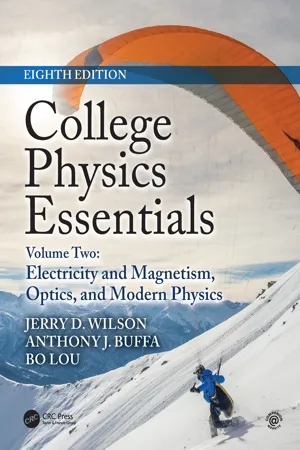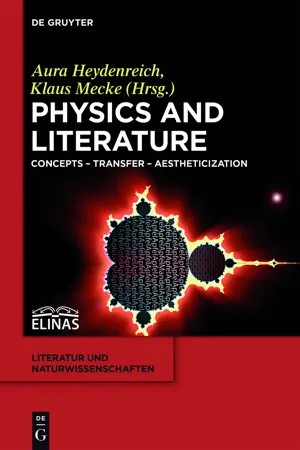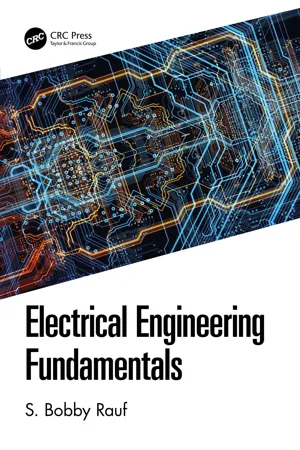Physics
Induced Potential
Induced potential refers to the creation of an electromotive force in a conductor due to a changing magnetic field. This phenomenon is governed by Faraday's law of electromagnetic induction, which states that a changing magnetic field induces an electric current in a nearby conductor. Induced potential plays a crucial role in the generation of electricity in power plants and the functioning of electric generators and transformers.
Written by Perlego with AI-assistance
Related key terms
Related key terms
1 of 4
Related key terms
1 of 3
7 Key excerpts on "Induced Potential"
- eBook - ePub
College Physics Essentials, Eighth Edition
Electricity and Magnetism, Optics, Modern Physics (Volume Two)
- Jerry D. Wilson, Anthony J. Buffa, Bo Lou(Authors)
- 2019(Publication Date)
- CRC Press(Publisher)
But how does this last step take place? Regardless of the source of the energy – the burning of fossil fuels; heat from a nuclear reactor, wind, waves, or falling water – the actual conversion to electric energy is accomplished by using magnetic fields and the concept of electromagnetic induction. This chapter not only examines the underlying principles of induction, but also discusses several practical applications. Last, it will be shown that the creation and propagation of electromagnetic radiation are intimately related to electromagnetic induction.20.1 Induced emf: Faraday’s Law and Lenz’s LawRecall from Section 17.1 that the term emf stands for electromotive force, which is an electric potential difference capable of causing an electric current. It is observed experimentally that a magnet, when held stationary near a conducting wire loop, does not induce an emf (and therefore induces no current) in that loop (▲ Figure 20.1a ). If the magnet is moved toward the loop, however, as in Figure 20.1b , the deflection of the galvanometer* needle indicates that current is created in the loop, but only during the motion of the magnet. Moreover, if the magnet is then moved away from the loop, as in Figure 20.1c , the galvanometer needle deflects in the opposite direction, which indicates a reversal of the current direction but, again, this only occurs during the motion of the magnet.▲ Figure 20.1 Electromagnetic induction (a) When there is no relative motion between the magnet and the wire loop, the number of field lines through the loop (in this case, seven) is constant, and the galvanometer (see text footnote) shows no deflection, indicating no induced current. (b) However, moving the magnet toward the loop increases the number of field lines passing through the loop (now twelve), and an induced current is detected. (c) Moving the magnet away from the loop decreases the number of field lines passing through the loop (to five). The result is that the induced current is now in the opposite direction. (Note the needle deflection.)Further experiments indicate that deflection of the galvanometer needle, indicating the presence of induced currents , also occurs if the loop is moved toward or away from a stationary magnet. Thus the inducing effect depends on the relative motion of loop and magnet. It has also been determined that the magnitude of the induced current depends on the speed of that motion. Experimentally, there is a noteworthy exception. If a loop is moved (but not rotated) in a uniform magnetic field, as shown in ▶ Figure 20.2 - eBook - ePub
- Anupam Garg(Author)
- 2012(Publication Date)
- Princeton University Press(Publisher)
5 Induced electromagnetic fieldsSo far, we have considered fields that are created either by static charges or by steady currents. In this chapter we consider electromagnetic fields that are induced by the time dependence of the fields themselves. A varying magnetic field is always accompanied by an electric field, and vice versa. These phenomena are described by the Faraday and Ampere-Maxwell laws. When we have these laws, a major milestone will have been reached, since we will then have the basic laws of electromagnetism in full.We also consider the energy in a static magnetic field in this chapter. Readers may wonder why this discussion is placed with that of time-dependent fields. The reason is that only changes in energy are meaningfully considered, and a change in a field configuration necessarily requires that we consider time dependence. However, it will turn out that the induced fields make a contribution only to the magnetic energy, and our earlier expression for the electrostatic energy will remain unchanged.Lastly, we will see how the scalar and vector potentials need to be modified to include the time dependence.28 Induction
In 1831 Faraday discovered that if a current-carrying coil (the primary) was moved back and forth near a static loop of wire (the secondary), a current was induced in the secondary. The same effect was observed if instead of the primary coil, a magnet was used. If instead of moving the primary, the current in it was turned off or on by means of a switch, a transitory pulse of current was seen to arise in the secondary immediately after the switch was operated.The common feature in the above experiments is that the magnetic field near the secondary coil is changing, which was eventually interpreted by Faraday as indicating that a changing magnetic field produces an electric field. This is because the current in the secondary shows that there is a force acting on the electrons in the wire, which can arise only if there is an electric field. (Recall that a static magnetic field by itself cannot produce a current in a nearby loop. Energy would be dissipated in the loop, and we have seen that a steady magnetic field can deliver no work to a charge.) This effect is known as induction - eBook - ePub
Physics and Literature
Concepts – Transfer – Aestheticization
- Aura Heydenreich, Klaus Mecke, Aura Heydenreich, Klaus Mecke(Authors)
- 2021(Publication Date)
- De Gruyter(Publisher)
or electricity to describe romantic attraction (i.e. love as magnetic attraction, etc.). What makes the above passages from Balzac and Poe remarkable and cutting-edge, is how they use magnetism and electricity together, to convey the workings of invisible interaction behind scientific inspiration and “human affections.” The discovery of electromagnetic induction provided then a new analogical model, based on a new type of difference and relation, particularly suited for the exploration of other elusive and puzzling relations at work in phenomena such as involuntary cognition.4 The term induction in electrical science
The electromagnetic difference also became a motor for exploration and discovery in physics. The various conceptual transformations undergone by the term induction from its initial meaning in electrostatics to Faraday’s redefinition provide an effective starting point for investigating the impact of this unprecedented motor in physics. Faraday begins the series of papers on his discovery of electromagnetic induction by defining the meaning of induction. The term comes from phenomena attributed to “electricity of tension,” or what we now call electrostatics:The power which electricity of tension possesses of causing an opposite electrical state in its vicinity has been expressed by the general term Induction; which, as it has been received into scientific language, may also, with propriety, be used in the same general sense to express the power which electrical currents may possess of inducing any particular state upon matter in their immediate neighbourhood, otherwise indifferent. It is with this meaning that I purpose using it in the present paper.(Faraday 1839a , 1)Unlike conduction, or charging by contact, induction refers to how a negatively charged object causes a positive electrical state in another object, or vice-versa, without apparent contact. Although they relied on different terminologies, historians credit Benjamin Franklin (1706–1790), John Canton (1718–1772), Johan Carl Wilcke (1732–1796), and Franz Aepinus (1724–1802) with the first formulation of the concept of electrostatic induction (Heilbron 1979 - eBook - ePub
- Jo Verhaevert(Author)
- 2024(Publication Date)
- Routledge(Publisher)
Chapter 5 Electromagnetism
DOI: 10.1201/9781003308294-5Learning Outcomes This chapter concerns the principles and laws governing electromagnetic induction and the concepts of self and mutual inductance. On completion of this chapter you should be able to use these principles to:- Understand the basic operating principles of motors and generators.
- Carry out simple calculations involving the generation of voltage, and the production of force and torque.
- Appreciate the significance of eddy current loss.
- Determine the value of inductors, and apply the concepts of self and mutual inductance to the operating principles of transformers.
- Calculate the energy stored in a magnetic field.
- Explain the principle of the moving coil metre and carry out simple calculations for the instrument.
5.1 Faraday’s Law of Electromagnetic Induction
It is mainly due to the pioneering work of Michael Faraday, in the nineteenth century, that the modern technological world exists as we know it. Without the development of the generation of electrical power, such advances would have been impossible. Thus, although the concepts involved with electromagnetic induction are very simple, they have far-reaching influence. Faraday’s law is best considered in two interrelated parts:- The value of emf induced in a circuit or conductor is directly proportional to the rate of change of magnetic flux linking with it.
- The polarity of such an emf, induced by an increasing flux, is opposite to that induced by a decreasing flux.
The key to electromagnetic induction is contained in part 1 of the law quoted above. Here, the words ‘rate of change’ are used. If there is no change in flux, or the way in which this flux links with a conductor, then no emf will be induced. The proof of the law can be very simply demonstrated. Consider a coil of wire, a permanent bar magnet and a galvanometer as illustrated in Figures 5.1 and 5.2 - eBook - ePub
- S. Bobby Rauf(Author)
- 2020(Publication Date)
- CRC Press(Publisher)
The term “electromotive” force stems from the early recognition of electrical current as something that consisted, strictly, of the movement of “electrons.” Nowadays, however, with the more recent breakthroughs in the renewable and non-traditional electrical power generating methods and systems like microbial fuel cells and hydrocarbon fuel cells, electrical power is being harnessed, more and more, in the form of charged particles that may not be electrons. In batteries, such as those used in automobiles, as we will see in the batteries chapter, the flow of current driven by voltage potential difference consists not only of negatively charged electrons, e −, but also types of ions, including H + and HSO 4 − ions. 1 Two, relatively putative, analogies for voltage in the mechanical and civil engineering disciplines are pressure and elevation. In the mechanical realm – or more specifically in the fluid and hydraulic systems – high pressure or pressure differential pushes fluid from one point to another and performs mechanical work. Similarly, voltage – in the form of voltage difference between two points, as with the positive and negative terminals of an automobile battery – moves electrons or charged particles through loads such as motors, coils, resistive elements, wires, or conductors. As electrons or charged particles are pushed through loads like motors, coils, resistive elements, light filaments, etc., electrical energy is converted into mechanical energy, heat energy, or light energy. In equipment like rechargeable batteries, during the charging process, applied voltage can push ions from one electrode (or terminal) to another and thereby “charge” the battery - Prem Prakash Srivastav, Deepak Kumar Verma, Ami R. Patel, Asaad Rehman Al-Hilphy, Prem Prakash Srivastav, Deepak Kumar Verma, Ami R. Patel, Asaad Rehman Al-Hilphy(Authors)
- 2020(Publication Date)
- Apple Academic Press(Publisher)
A transformer can transfer electrical energy between the primary and secondary side through magnetic flux without any frequency change. A varying voltage applied to the primary coil induces a magnetic flux in the magnetic circuit. Thereby, an induced voltage (electromotive force, EMF) is generated in the secondary coil (Suresh and Panda, 2016). If a load is connected to a secondary coil that permits the flow of an induced current, this current creates “winding loss” and “load loss” in the secondary coil and the load, respectively. The terms are applied regardless of whether the coil and load are made of copper or another conductive medium, such as food and electrolyte solution. These losses are caused by Joule heating and represent an undesirable energy transfer in the energy industry (Villén et al., 2013; Khabdullin et al., 2017). Through rational system design, induced electric fields (IEFs) (potential difference) induced by various magnetic fluxes in liquid sample could possibly be an alternative approach for nonthermal processing. 10.2 INDUCED ELECTRIC FIELD (IEF) PROCESSING THEORY 10.2.1 INDUCTIVE METHODOLOGY An alternating electric field is induced by alternating magnetic field as per the Faraday’s law of electromagnetic induction (Saslow, 2002). Based on this characteristic, the potential difference between two coils is controllable by differential magnetic fluxes. For the treatment of foods, magneto-IEF could be utilized via the experimental transformer system. The production of IEFs in liquid foods with various field strengths and frequencies is feasible through synchronous alternating magnetic fluxes. A transformer contains a primary coil and a secondary coil, linked by a magnetic circuit. According to its working principle, induced voltages are generated in the two coils because of the changing flux. Figure 10.1 shows a typical transformer containing primary coil, secondary coil, and magnetic circuit (or the magnetic core)- eBook - ePub
- Adrian Waygood(Author)
- 2018(Publication Date)
- Routledge(Publisher)
Chapter 5 Potential and potential differenceObjectives
On completion of this chapter, you should be able to- explain the need for external negative and positive potentials to cause current in a conductor.
- describe simple electric field patterns.
- explain the terms, potential and potential difference in terms of charge movement within electric fields.
- explain what is meant by ‘charge separation’.
- state the SI unit of measurement of potential difference.
- briefly explain the differences between each of the following terms:
- potential difference
- voltage
- electromotive force
- potential.
Introduction
In Chapter 3 , we learnt that if we applied an external negative charge to one end of a metal conductor, and an external positive charge to the other end of that conductor, a drift of free electrons (an electric current) will take place through that conductor, as illustrated in Figure 5.1 .Figure 5.1We describe the external negative charge as having a negative ‘potential ’, and the external positive charge as having a positive ‘potential ’. The difference between these potentials, therefore, is called a ‘potential difference ’, and it is this which provides the ‘driving force’ for a current.So, for charge carriers to flow between two points,- we need a conducting path between those two points.
- there must be a potential difference between the two points.
But what exactly do we mean by ‘potential ’ and ‘potential difference ’, and where do they come from? In order to understand these terms, we need a basic understanding of electric fields .Electric fields
The area surrounding an electric charge, in which the effects of that charge may be observed, is termed an ‘electric field ’.An electric field is graphically represented using lines of force, called ‘electric flux ’. It must be clearly understood that these electric flux lines are imaginary – in other words, the lines themselves don’t actually exist, but are used simply to provide us with a ‘model’ (a visual representation) of an electric field in exactly the same way as magnetic
Index pages curate the most relevant extracts from our library of academic textbooks. They’ve been created using an in-house natural language model (NLM), each adding context and meaning to key research topics.
Explore more topic indexes
Explore more topic indexes
1 of 6
Explore more topic indexes
1 of 4






